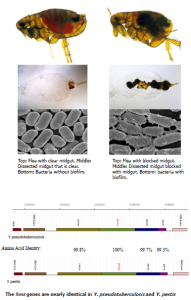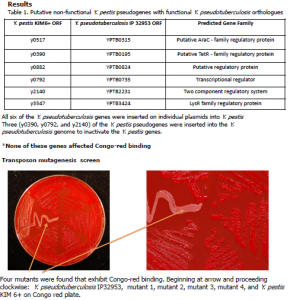Ryan Stewart and Dr. David Erickson
Abstract
The plague bacterium Yersiniapestisrecently evolved from the enteric pathogen Yersiniapseudotuberculosis, during which time it has adopted a flea-borne lifestyle. Y. pestisforms a biofilmin the flea digestive tract to enhance transmission, whereas Y. pseudotuberculosisdoes not. Biofilmformation requires the hmsgenes, which direct the production of an N-acetylglucosamineextracellular matrix (ECM) that absorbs Congo-red (CR) dye, and Y. pestistypically forms pigmented colonies on CR agar. The Hmsproteins of Y. pestisand Y. pseudotuberculosisare identical, yet most Y. pseudotuberculosisisolates are non-pigmented on CR agar. Despite extremely high overall similarity, Y. pestishas lost the function of ~120 genes that appear intact in Y. pseudotuberculosis. Among these non-functional genes are putative transcriptional regulators, and other genes that could affect the production or stability of the HmsECM. Inactivation of these genes in Y. pestiscould have enhanced biofilmand flea-borne transmission. We inserted functional copies (from Y. pseudotuberculosis) of six predicted regulatory genes into Y. pestison plasmids. We also replaced the Y. pseudotuberculosisfunctional copies of three genes with non-functional Y. pestisversions. The CR binding phenotypes were not changed by any of these changes. We also used random transposonmutagenesis to identify mutants of Y. pseudotuberculosisthat bind CR dye. We found four separate mutants that stably express a CR-positive phenotype. We mapped the insertion sites for three of the mutants, which included a putative bacteriophagetail fiber gene, the stationary-phase response protein Dps, and a putative polysaccharide deacetylasegene.. The polysaccharide deacetylaseof Y. pestishas a single amino-acid change in the conserved deacetylasedomain compared to the Y. pseudotuberculosisversion, which may affect its activity. Future work will focus on characterizing the function of this deacetylasein both Y. pestisand Y. pseudotuberculosis.
Introduction
- Y. pestisevolved from Y. pseudotuberculosiswithin the past 20K years, and these two species have extremely similar genomes. Y. pestisis in the early stages of genome decay, with ~120 non-functional pseudogenescompared with Y. pseudotuberculosis.
- For efficient transmission, Y. pestismust form a biofilmin the flea proventriculus
- Biofilmformation requires the hmsHFRSoperon
- The Hmsproteins produce an extracellular polysaccharide that binds congo-red dye
- Even though the hmsgenes are present in Y. pseudotuberculosis, it forms non-pigmented colonies on Congo-red agar and does not block fleas
Hypothesis
Y. pseudotuberculosishas genes that prevent expression or activity of the Hmsproteins or stability of the polysaccharide
Experimental Approach to Test Hypothesis
1)Identify potential transcriptional regulatory genes from Y. pestisand Y. pseuotuberculosisgenomes where the Y. pestisversion is likely non-functional. Insert putative regulatory genes from Y. pseudotuberculosis(predicted to be functional) into Y. pestis.
2)Replace functional Y. pseudotuberculosisregulatory genes with non-functional Y. pestisversions. Screen recombinant strains (from 1 and 2) for altered Congo-red binding phenotypes.
3)Create a random transposonmutant library of Y. pseudotuberculosis. Screen for mutants that bind Congo-red dye. Examine mutants for differences in biofilmand motility.
Materials and Methods
Recombinant DNA techniques
Y. pestispseudogeneswere cloned by PCR and inserted into Y. pseudotuberculosisusing the pMRS101 suicide vector, through bi-parental matingswith E. coli S17-1λpir. The functional copy of the genes from Y. pseudotuberculosiswere amplified by PCR and inserted into the pCR2.1 cloning vector. Recombinant plasmids were then inserted into Y. pestisby electroporation.
Transposonmutagenesis
YersiniapseudotuberculosisIP32953 were mated with Escherichia coli S17-1λpircells containing a Tn5 transposonwith a kanamycinresistance gene. Approximately 30,000 mutants were plated on Congo-red agar plates and grown at room temperature for 2 days. Mutant colonies that were significantly more pigmented than the wild-type Y. pseudotuberculosiswere selected.
Sequencing of transposoninsertion sites
Arbitrary PCR was used to amplify regions of the Y. pseudotuberculosisgenome that flank the transposon. The arbitrary PCR products were sequenced using BigDye3.1 mix and primers that read out from both ends of the transposon. These sequences were then BLASTedagainst the Y. pseudotuberculosisgenome to identify the insertion sites.
Motility Assay
Y. pseudotuberculosisstrains were grown on 3% agar swim plates at room temperature. The bacteria were spotted on the middle of the plates and the diameters of growth were measured at 24 hour intervals.
BiofilmAssay
Yersiniastrains were grown over night at room temperature. The cultures were restarted at an O.D.600of 0.3 in 40% Brain-Heart Infusion broth and shook (200 rpm) at room temperature for 48 hours in a 24-well plate. The planktonicbacteria were removed and the wells were washed with 2.5 ml of water and stained with 2.5 ml of crystal violet for 10 minutes. After the unbound crystal violet was removed, the crystal violet adhering to the biofilmwas solubilizedwith an acetone (20%) and ethanol (80%) solution and measured at A570nm.
Results
Conclusions and Future Work
We identified 4 Y. pseudotuberculosisgenes that might negatively affect the Hms-dependent extracellular polysaccharide.
Three of the transposonmutants are hyper-motile compared with the wild-type strain.
Of the four genes, none are obviously non-functional in Y. pestis, indicating that they might not be expressed or might have different functions in Y. pestis
We will inactivate these genes in Y. pestisand determine if biofilmformation in vitro and in fleas are affected
We will complement these mutants to test for polar effects of the transposoninsertions
We will express and purify recombinant polysaccharide deacetlyaseto determine if it has activity against the Hmspolysaccharide
The dpsgene may be important for resisting reactive oxygen species and bacterial survival in fleas. We will test this mutant to determine if it is susceptible to hydrogen peroxide or if it can survive in the flea midgut.



